Yanyan Li
Large Language Model-Driven Closed-Loop UAV Operation with Semantic Observations
Jul 03, 2025Abstract:Recent advances in large Language Models (LLMs) have revolutionized mobile robots, including unmanned aerial vehicles (UAVs), enabling their intelligent operation within Internet of Things (IoT) ecosystems. However, LLMs still face challenges from logical reasoning and complex decision-making, leading to concerns about the reliability of LLM-driven UAV operations in IoT applications. In this paper, we propose a LLM-driven closed-loop control framework that enables reliable UAV operations powered by effective feedback and refinement using two LLM modules, i.e., a Code Generator and an Evaluator. Our framework transforms numerical state observations from UAV operations into natural language trajectory descriptions to enhance the evaluator LLM's understanding of UAV dynamics for precise feedback generation. Our framework also enables a simulation-based refinement process, and hence eliminates the risks to physical UAVs caused by incorrect code execution during the refinement. Extensive experiments on UAV control tasks with different complexities are conducted. The experimental results show that our framework can achieve reliable UAV operations using LLMs, which significantly outperforms baseline approaches in terms of success rate and completeness with the increase of task complexity.
4D Gaussian Splatting SLAM
Mar 20, 2025Abstract:Simultaneously localizing camera poses and constructing Gaussian radiance fields in dynamic scenes establish a crucial bridge between 2D images and the 4D real world. Instead of removing dynamic objects as distractors and reconstructing only static environments, this paper proposes an efficient architecture that incrementally tracks camera poses and establishes the 4D Gaussian radiance fields in unknown scenarios by using a sequence of RGB-D images. First, by generating motion masks, we obtain static and dynamic priors for each pixel. To eliminate the influence of static scenes and improve the efficiency on learning the motion of dynamic objects, we classify the Gaussian primitives into static and dynamic Gaussian sets, while the sparse control points along with an MLP is utilized to model the transformation fields of the dynamic Gaussians. To more accurately learn the motion of dynamic Gaussians, a novel 2D optical flow map reconstruction algorithm is designed to render optical flows of dynamic objects between neighbor images, which are further used to supervise the 4D Gaussian radiance fields along with traditional photometric and geometric constraints. In experiments, qualitative and quantitative evaluation results show that the proposed method achieves robust tracking and high-quality view synthesis performance in real-world environments.
MVGSR: Multi-View Consistency Gaussian Splatting for Robust Surface Reconstruction
Mar 11, 2025



Abstract:3D Gaussian Splatting (3DGS) has gained significant attention for its high-quality rendering capabilities, ultra-fast training, and inference speeds. However, when we apply 3DGS to surface reconstruction tasks, especially in environments with dynamic objects and distractors, the method suffers from floating artifacts and color errors due to inconsistency from different viewpoints. To address this challenge, we propose Multi-View Consistency Gaussian Splatting for the domain of Robust Surface Reconstruction (\textbf{MVGSR}), which takes advantage of lightweight Gaussian models and a {heuristics-guided distractor masking} strategy for robust surface reconstruction in non-static environments. Compared to existing methods that rely on MLPs for distractor segmentation strategies, our approach separates distractors from static scene elements by comparing multi-view feature consistency, allowing us to obtain precise distractor masks early in training. Furthermore, we introduce a pruning measure based on multi-view contributions to reset transmittance, effectively reducing floating artifacts. Finally, a multi-view consistency loss is applied to achieve high-quality performance in surface reconstruction tasks. Experimental results demonstrate that MVGSR achieves competitive geometric accuracy and rendering fidelity compared to the state-of-the-art surface reconstruction algorithms. More information is available on our project page (\href{https://mvgsr.github.io}{this url})
GSCE: A Prompt Framework with Enhanced Reasoning for Reliable LLM-driven Drone Control
Feb 18, 2025



Abstract:The integration of Large Language Models (LLMs) into robotic control, including drones, has the potential to revolutionize autonomous systems. Research studies have demonstrated that LLMs can be leveraged to support robotic operations. However, when facing tasks with complex reasoning, concerns and challenges are raised about the reliability of solutions produced by LLMs. In this paper, we propose a prompt framework with enhanced reasoning to enable reliable LLM-driven control for drones. Our framework consists of novel technical components designed using Guidelines, Skill APIs, Constraints, and Examples, namely GSCE. GSCE is featured by its reliable and constraint-compliant code generation. We performed thorough experiments using GSCE for the control of drones with a wide level of task complexities. Our experiment results demonstrate that GSCE can significantly improve task success rates and completeness compared to baseline approaches, highlighting its potential for reliable LLM-driven autonomous drone systems.
Street Gaussians without 3D Object Tracker
Dec 07, 2024



Abstract:Realistic scene reconstruction in driving scenarios poses significant challenges due to fast-moving objects. Most existing methods rely on labor-intensive manual labeling of object poses to reconstruct dynamic objects in canonical space and move them based on these poses during rendering. While some approaches attempt to use 3D object trackers to replace manual annotations, the limited generalization of 3D trackers -- caused by the scarcity of large-scale 3D datasets -- results in inferior reconstructions in real-world settings. In contrast, 2D foundation models demonstrate strong generalization capabilities. To eliminate the reliance on 3D trackers and enhance robustness across diverse environments, we propose a stable object tracking module by leveraging associations from 2D deep trackers within a 3D object fusion strategy. We address inevitable tracking errors by further introducing a motion learning strategy in an implicit feature space that autonomously corrects trajectory errors and recovers missed detections. Experimental results on Waymo-NOTR datasets show we achieve state-of-the-art performance. Our code will be made publicly available.
Learnable Infinite Taylor Gaussian for Dynamic View Rendering
Dec 05, 2024



Abstract:Capturing the temporal evolution of Gaussian properties such as position, rotation, and scale is a challenging task due to the vast number of time-varying parameters and the limited photometric data available, which generally results in convergence issues, making it difficult to find an optimal solution. While feeding all inputs into an end-to-end neural network can effectively model complex temporal dynamics, this approach lacks explicit supervision and struggles to generate high-quality transformation fields. On the other hand, using time-conditioned polynomial functions to model Gaussian trajectories and orientations provides a more explicit and interpretable solution, but requires significant handcrafted effort and lacks generalizability across diverse scenes. To overcome these limitations, this paper introduces a novel approach based on a learnable infinite Taylor Formula to model the temporal evolution of Gaussians. This method offers both the flexibility of an implicit network-based approach and the interpretability of explicit polynomial functions, allowing for more robust and generalizable modeling of Gaussian dynamics across various dynamic scenes. Extensive experiments on dynamic novel view rendering tasks are conducted on public datasets, demonstrating that the proposed method achieves state-of-the-art performance in this domain. More information is available on our project page(https://ellisonking.github.io/TaylorGaussian).
Large Language Models show both individual and collective creativity comparable to humans
Dec 04, 2024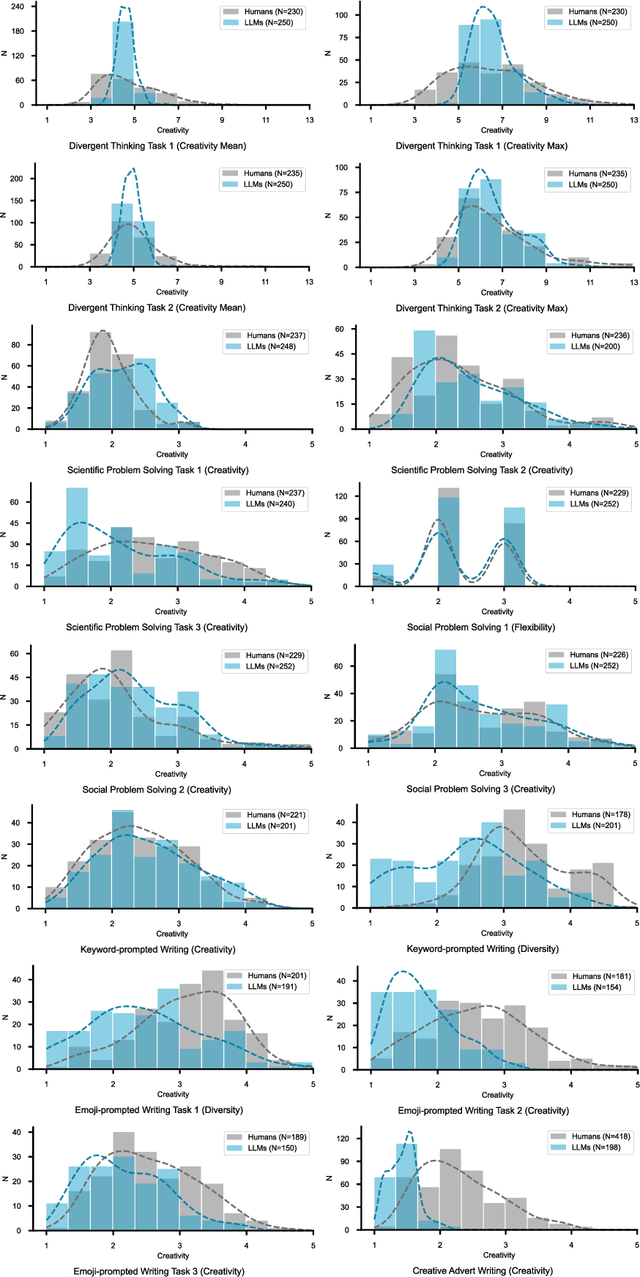
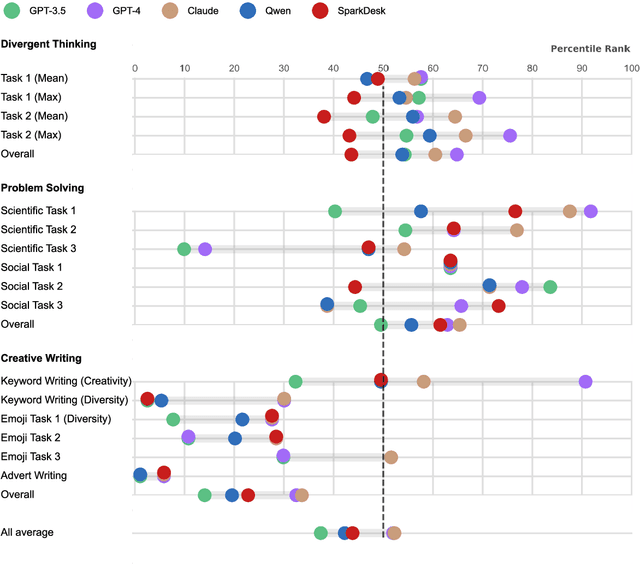
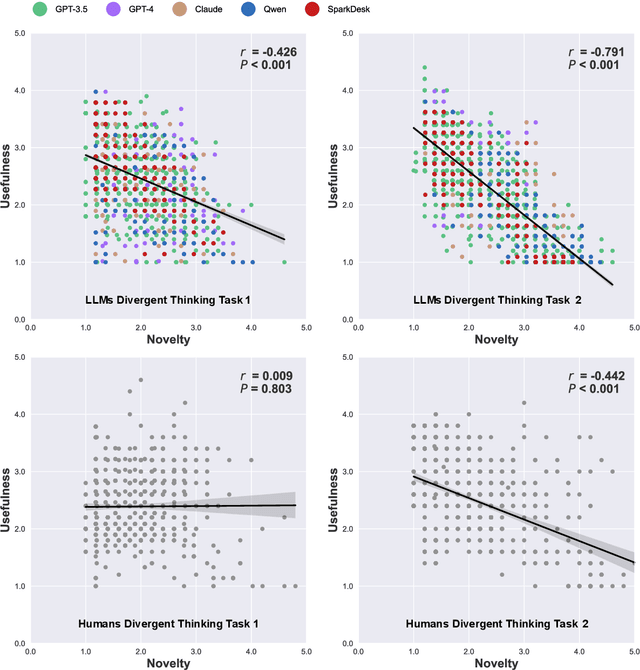
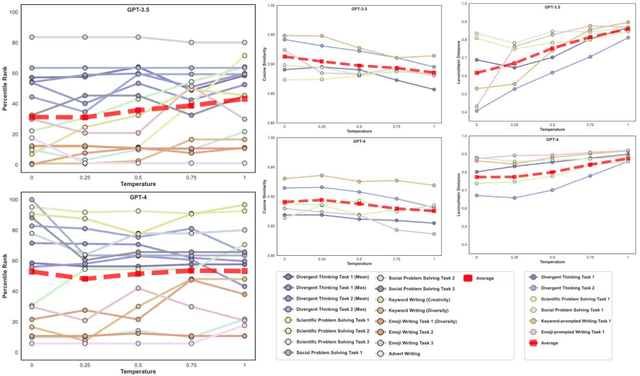
Abstract:Artificial intelligence has, so far, largely automated routine tasks, but what does it mean for the future of work if Large Language Models (LLMs) show creativity comparable to humans? To measure the creativity of LLMs holistically, the current study uses 13 creative tasks spanning three domains. We benchmark the LLMs against individual humans, and also take a novel approach by comparing them to the collective creativity of groups of humans. We find that the best LLMs (Claude and GPT-4) rank in the 52nd percentile against humans, and overall LLMs excel in divergent thinking and problem solving but lag in creative writing. When questioned 10 times, an LLM's collective creativity is equivalent to 8-10 humans. When more responses are requested, two additional responses of LLMs equal one extra human. Ultimately, LLMs, when optimally applied, may compete with a small group of humans in the future of work.
SmileSplat: Generalizable Gaussian Splats for Unconstrained Sparse Images
Nov 27, 2024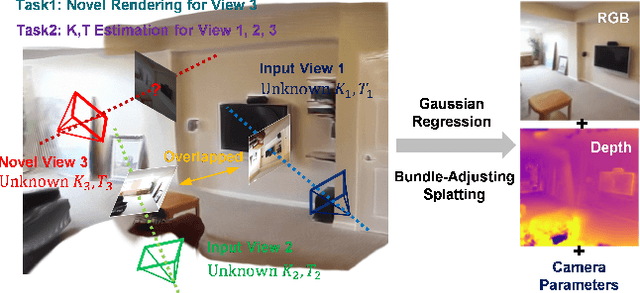



Abstract:Sparse Multi-view Images can be Learned to predict explicit radiance fields via Generalizable Gaussian Splatting approaches, which can achieve wider application prospects in real-life when ground-truth camera parameters are not required as inputs. In this paper, a novel generalizable Gaussian Splatting method, SmileSplat, is proposed to reconstruct pixel-aligned Gaussian surfels for diverse scenarios only requiring unconstrained sparse multi-view images. First, Gaussian surfels are predicted based on the multi-head Gaussian regression decoder, which can are represented with less degree-of-freedom but have better multi-view consistency. Furthermore, the normal vectors of Gaussian surfel are enhanced based on high-quality of normal priors. Second, the Gaussians and camera parameters (both extrinsic and intrinsic) are optimized to obtain high-quality Gaussian radiance fields for novel view synthesis tasks based on the proposed Bundle-Adjusting Gaussian Splatting module. Extensive experiments on novel view rendering and depth map prediction tasks are conducted on public datasets, demonstrating that the proposed method achieves state-of-the-art performance in various 3D vision tasks. More information can be found on our project page (https://yanyan-li.github.io/project/gs/smilesplat)
Robust Gaussian Splatting SLAM by Leveraging Loop Closure
Sep 30, 2024Abstract:3D Gaussian Splatting algorithms excel in novel view rendering applications and have been adapted to extend the capabilities of traditional SLAM systems. However, current Gaussian Splatting SLAM methods, designed mainly for hand-held RGB or RGB-D sensors, struggle with tracking drifts when used with rotating RGB-D camera setups. In this paper, we propose a robust Gaussian Splatting SLAM architecture that utilizes inputs from rotating multiple RGB-D cameras to achieve accurate localization and photorealistic rendering performance. The carefully designed Gaussian Splatting Loop Closure module effectively addresses the issue of accumulated tracking and mapping errors found in conventional Gaussian Splatting SLAM systems. First, each Gaussian is associated with an anchor frame and categorized as historical or novel based on its timestamp. By rendering different types of Gaussians at the same viewpoint, the proposed loop detection strategy considers both co-visibility relationships and distinct rendering outcomes. Furthermore, a loop closure optimization approach is proposed to remove camera pose drift and maintain the high quality of 3D Gaussian models. The approach uses a lightweight pose graph optimization algorithm to correct pose drift and updates Gaussians based on the optimized poses. Additionally, a bundle adjustment scheme further refines camera poses using photometric and geometric constraints, ultimately enhancing the global consistency of scenarios. Quantitative and qualitative evaluations on both synthetic and real-world datasets demonstrate that our method outperforms state-of-the-art methods in camera pose estimation and novel view rendering tasks. The code will be open-sourced for the community.
LiLoc: Lifelong Localization using Adaptive Submap Joining and Egocentric Factor Graph
Sep 16, 2024



Abstract:This paper proposes a versatile graph-based lifelong localization framework, LiLoc, which enhances its timeliness by maintaining a single central session while improves the accuracy through multi-modal factors between the central and subsidiary sessions. First, an adaptive submap joining strategy is employed to generate prior submaps (keyframes and poses) for the central session, and to provide priors for subsidiaries when constraints are needed for robust localization. Next, a coarse-to-fine pose initialization for subsidiary sessions is performed using vertical recognition and ICP refinement in the global coordinate frame. To elevate the accuracy of subsequent localization, we propose an egocentric factor graph (EFG) module that integrates the IMU preintegration, LiDAR odometry and scan match factors in a joint optimization manner. Specifically, the scan match factors are constructed by a novel propagation model that efficiently distributes the prior constrains as edges to the relevant prior pose nodes, weighted by noises based on keyframe registration errors. Additionally, the framework supports flexible switching between two modes: relocalization (RLM) and incremental localization (ILM) based on the proposed overlap-based mechanism to select or update the prior submaps from central session. The proposed LiLoc is tested on public and custom datasets, demonstrating accurate localization performance against state-of-the-art methods. Our codes will be publicly available on https://github.com/Yixin-F/LiLoc.
 Add to Chrome
Add to Chrome Add to Firefox
Add to Firefox Add to Edge
Add to Edge